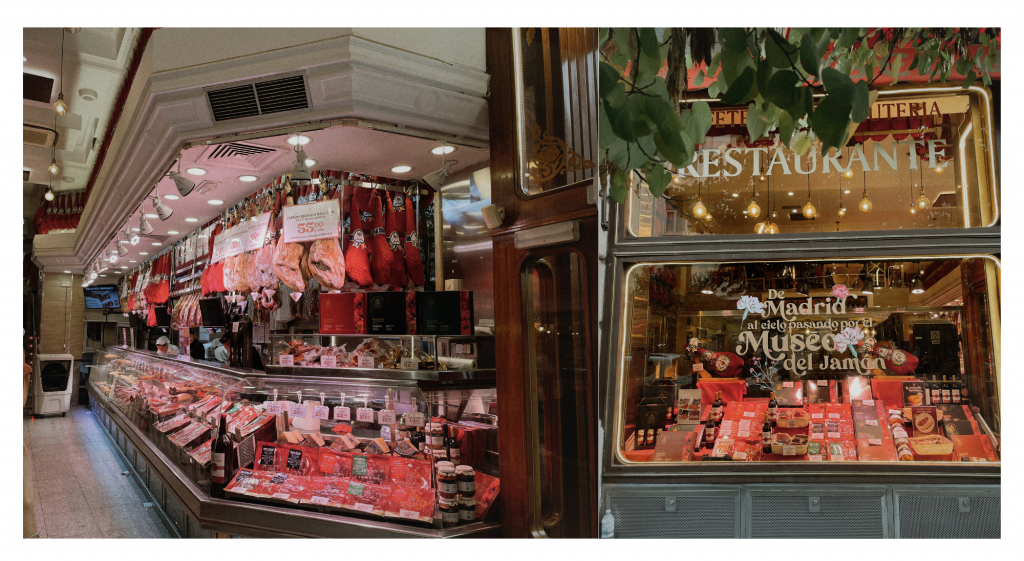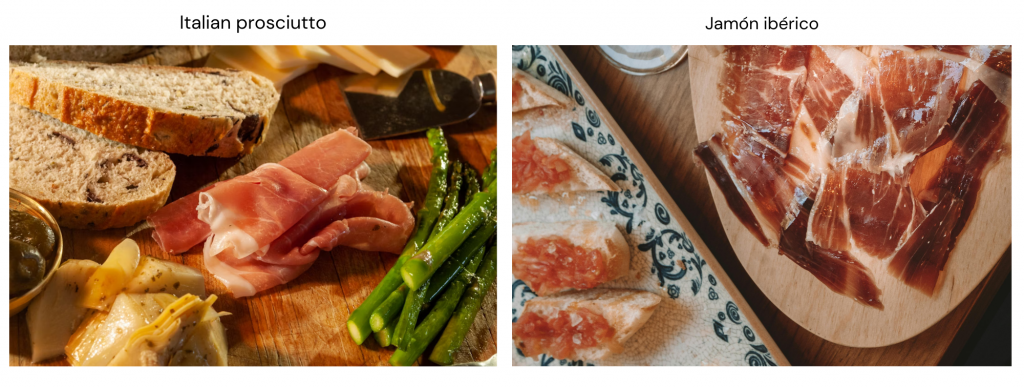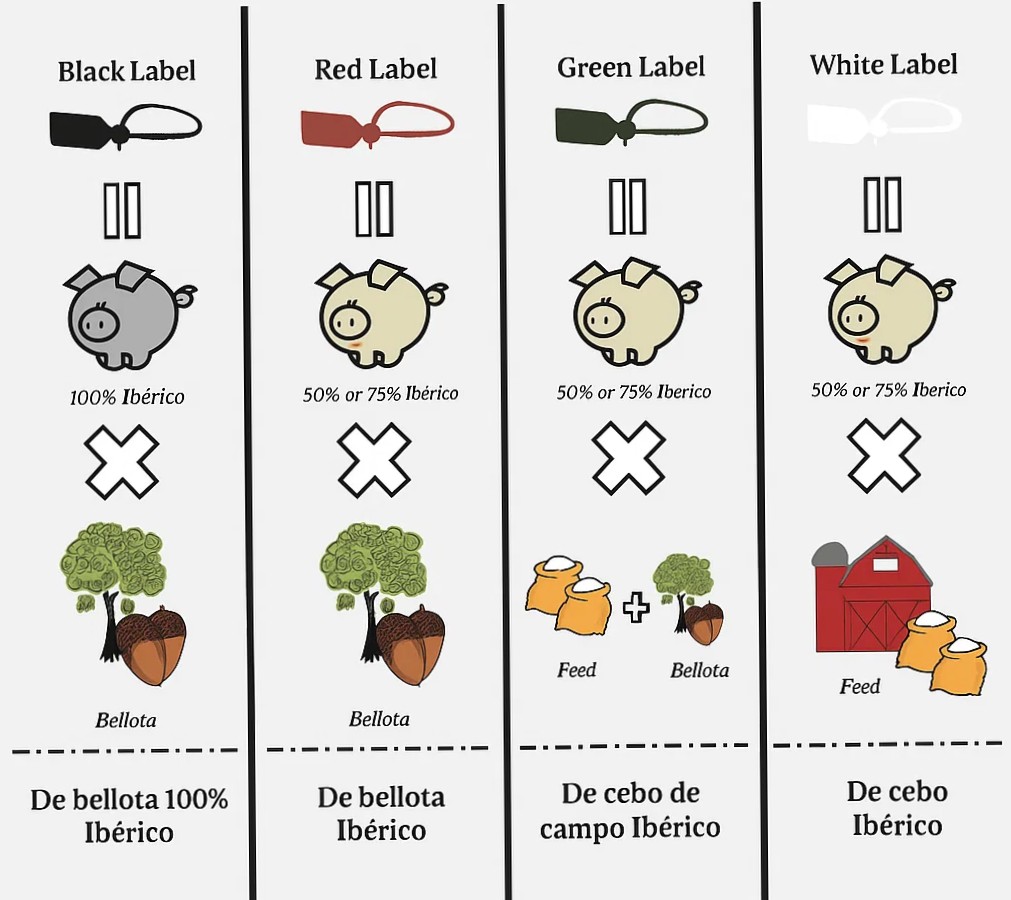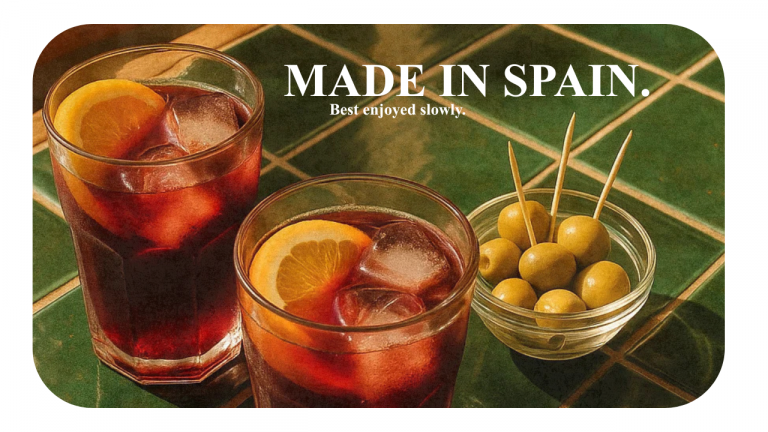
Walking the streets of Spain, especially in Madrid, you can’t help but notice jamón. In small shop windows, whole legs of cured meat hang like edible trophies. In the supermarket, you glance at the fridge and spot “jamón Ibérico” proudly wrapped with award stickers. I remember sitting down for breakfast with a friend who had been living in Spain for years, ordering me breakfast: tostada con tomate y jamón Ibérico. ‘It’s the most traditional breakfast here,’ she said. Those two famous Spanish words seemed to follow me everywhere. You can’t avoid them, and trust me, you don’t want to.
📌 This is just what I’ve picked up living in Spain and doing my own research. I’m no jamón Ibérico or ham expert, but after all this tasting and research, I’m starting to think my PhD in ham could be around the corner. 💡 Here is what I learned about this Spanish treasure.
At first glance, it was hard not to compare it to the Italian Prosciutto. On the surface, they look pretty similar, but it turns out they have more differences than similarities. Both jamón and prosciutto mean ‘ham’ in Italian and Spanish, and both are dry-cured hind pig legs. What is the difference? Of course, let’s start with the basics. The Italian prosciutto, the kind simply labeled prosciutto crudo without a protected designation like Parma or San Daniele, can be made in many regions of Italy. The curing process is, in fact, very different.
👉 Jamón vs. Prosciutto: Key Differences:
| Feature | Jamón | Prosciutto |
|---|---|---|
| Curing Time | 12–36 months (some up to 48) | 9–24 months |
| Salt Usage | Heavy, making the meat drier and firmer | Less, resulting in a softer, more delicate texture |
| Slicing Method | By hand on a jamonero; very thin but irregular slices | Usually by machine; paper-thin, uniform slices |
| Texture & Flavor | Firmer, more intense flavor | Usually by machine, paper-thin, uniform slices |

But prosciutto is just a side character here – jamón deserves the spotlight. Let’s focus only on jamón now. There are two main types of Spanish jamón:
- Jamón Ibérico: From native breed called Iberian pigs (often black-hoofed). Raised outdoors in dehesa forests, roaming freely, especially in southwestern Spain. Per regulations, there shouldn’t be more than two pigs per hectare of grassland. The pigs eat mostly olives, nuts, and berries. Special subtypes include Jamón Ibérico de Bellota, where pigs eat acorns for a nutty flavor.
- Jamón Serrano: From white pigs, cured for 7–16 months. Named after the word “sierra” (mountain), because traditionally it was cured in cool, dry mountain air. They are not raised in a specific ecosystem; they could be anywhere in Spain. Usually in agricultural land or farms, sometimes in indoor facilities, and in more intensive farming. The diet is mostly grain-fed, including cereals like corn and barley.
💡 The main differences are in pig breed, diet, curing process, climate, and slicing method, which all affect flavor and texture. Serrano is also traditional and accessible, but Ibérico has the deeper historical roots in Spain’s ham culture and it’s culturally iconic.
The Spanish are very proud of their jamón. Seeing it loudly displayed on every corner shows how deeply braided it is into Spanish culture and daily life:
- Culinary Tradition: It represents centuries of Spanish aging ham expertise. Families, local restaurants, and markets all take pride in this craft, making it a delicious symbol of Spain’s heritage and dedication to quality. There are even jamón iberico festivals, where people celebrate, taste different varieties, and learn from expert carvers, showing how deeply it’s ingrained in Spanish culture.
- Social Connection: Jamón is often shared at gatherings, tapas bars, family gatherings, and celebrations. You notice people gathering around tables, and almost every time, there are some slices of jamón Ibérico in the mix. It’s an excuse to slow down, enjoy the flavors, and connect with the people around you.
- Regional Identity: Different regions, especially in southwestern Spain, are known for specific types of jamón Ibérico. It’s a way of expressing local pride.
- Ritual and Respect: Watching a skilled jamónero carve jamón is almost like a little ceremony. The care, patience, and attention they put into each slice really show how much the Spanish value slowing down and enjoying their food – values reflected in Spanish dining culture.
✔ INTERESTING FACTS:
- Sometimes you’ll see ‘paleta’ on jamón packaging – this means it comes from the pig’s front leg, while ‘jamón’ always refers to the hind leg,
- Iberian Bellota ham is a global delicacy, with some pieces selling for over €4,000,
- Jamón so good it deserves a museum! Visit Museo del Jamón in Madrid to taste this iconic Spanish delicacy,
- There are different types of jamón Iberico. Here’s a quick guide to the different types:

💌 Today’s note:
If you’re trying Spanish jamón for the first time, slow down and do it right. Grab some fresh, crusty bread, a few black olives, some good company, and enjoy it like a true Spaniard. And don’t even think about the Italian prosciutto, this isn’t a polite neighbor; this is the bold, flamenco-dancing star of the tapas table.
⤷ In Madrid alone, there are a few Jamón Ibérico Museum locations, each offering travelers a chance to experience the artistry of Spain’s most iconic ham.
⤷ You can learn more about their locations and experiences [Museo del Jamón].


